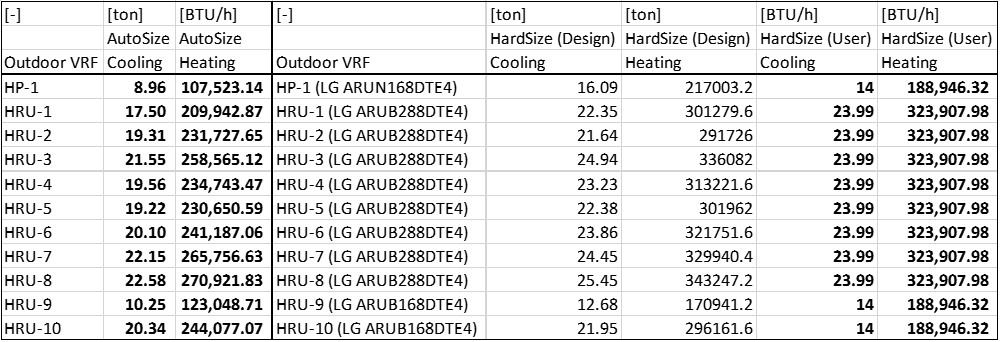So, I am trying to do a LEED 2009/ASHRAE 90.1-2010 model of simple 100 kft2 two story office building in San Antonio, TX (OpenStudio 2.4/EnergyPlus). The proposed building has VRF (10 + 1 outdoor units) and DOAS (2 rooftop units). To get an idea of the building, I did one model where I auto-sized everything for all VRF. This comes out very clean on the unmet hours, but unfortunately does not meet the 10% EUI reduction (I was told that the default VRF do not have good unloading curves).
So then I replaced all VRF units with the LG units available from BCL, and I picked the sized roughly based on the auto-sized runs. No almost everything is hard-sized instead of auto-sized. Also, I made no changes to the DOAS. This does seem to reduced the EUI essentially as needed, HOWEVER, now I have HUGE unmet cooling hours.
My first inclination was that this is due to undersized VRF components. However, I went through both models painstakingly. Both size out exactly the same on the HVAC Sizing Summary, as I would expect. But here is the odd thing, the auto-sized components come out SMALLER than the hard-sized components on the Component Summary, as shown in the table below.

And now I wonder why a (seemingly?) much stronger hard-sized system is troubled by unmet cooling hours, when the auto-sized system sails right through it without any trouble whatsoever? All but one outdoor units use heat recovery and no there are no other (known to me) differences between the auto-sized and hard-sized models.
I am quite literally at my wit's end and have a deadline coming up.
Also, just to see if I understand how zones turn into systems, for each zone, I took the sensible heat load (user, not calculated, though they are the same in my models, as all sizing factors are unity) and divided it by the sensible heat ratio reported for the VRF indoor unit serving that zone. However, I find that this is typically on the order of 10% to 15% smaller than the capacity reported for the VRF indoor unit?




